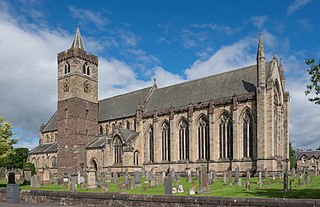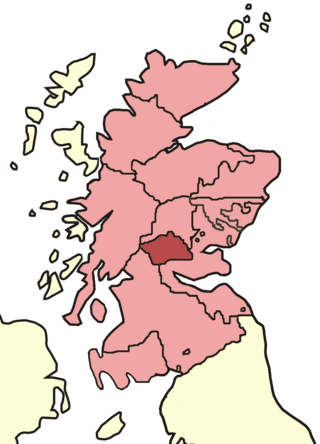
Dunblane is a small town in the council area of Stirling in central Scotland, and inside the historic boundaries of the county of Perthshire. It is a commuter town, with many residents making use of good transport links to much of the Central Belt, including Glasgow and Edinburgh.

The Stirling council area is one of the 32 council areas of Scotland, and has a population of about 94,330. It was created in 1975 as a lower-tier district within the Central region. The district covered parts of the historic counties of Stirlingshire and Perthshire, which were abolished for local government purposes. In 1996 the Central region was abolished and Stirling Council took over all local government functions within the area.

Dunblane Cathedral is the larger of the two Church of Scotland parish churches serving Dunblane, near the city of Stirling, in central Scotland.

The Bishop of Dunblane or Bishop of Strathearn was the ecclesiastical head of the Diocese of Dunblane or Strathearn, one of medieval Scotland's thirteen bishoprics. It was based at Dunblane Cathedral, now a parish church of the Church of Scotland. The bishopric itself certainly derives from an older Gaelic Christian community. According to legend, the Christian community of Dunblane was derived from the mission of St. Bláán, a saint originally associated with the monastery of Cenn Garath (Kingarth) on the Isle of Bute. Although the bishopric had its origins in the 1150s or before, the cathedral was not built nor was the seat (cathedra) of the diocese fixed at Dunblane until the episcopate of Clement.

The Leighton Library, or Bibliotheca Leightoniana, in The Cross, Dunblane, is the oldest purpose built library in Scotland and also has a well-documented history as one of the earliest public subscription libraries in Scotland. Its collection of around 4000 volumes and 78 manuscripts from the 16th to 19th century is founded on the personal collection of Robert Leighton (1611–1684), Minister at Newbattle, Principal of Edinburgh University, Bishop of Dunblane and Archbishop of Glasgow. Robert Leighton's personal collection consisted of 1,400 books and the Leighton Library was built to host the books which had been left to Dunblane Cathedral.
Clement was a 13th-century Dominican friar who was the first member of the Dominican Order in Britain and Ireland to become a bishop. In 1233, he was selected to lead the ailing diocese of Dunblane in Scotland, and faced a struggle to bring the bishopric of Dunblane to financial viability. This involved many negotiations with the powerful religious institutions and secular authorities which had acquired control of the revenue that would normally have been the entitlement of Clement's bishopric. The negotiations proved difficult, forcing Clement to visit the papal court in Rome. While not achieving all of his aims, Clement succeeded in saving the bishopric from relocation to Inchaffray Abbey. He also regained enough revenue to begin work on the new Dunblane Cathedral.

Muthill, pronounced, is a village in Perth and Kinross, Perthshire, Scotland. The name derives from scottish gaelic Maothail meaning “soft-ground”.

St Mary's Episcopal Church is a medium-sized church of the Scottish Episcopal Church in Dunblane, Scotland. It is situated by the Fourways roundabout.

St Ninian's Cathedral in Perth is a cathedral of the Scottish Episcopal Church in the Diocese of St Andrews, Dunkeld and Dunblane.

Albin was a 13th-century prelate of the Kingdom of Scotland. A university graduate, Albin is known for his ecclesiastical career in the diocese of Brechin, centred on Angus in east-central Scotland.
William de Cambuslang was a 14th-century Scottish churchman, presumably coming from a family based at or originating from Cambuslang near Glasgow.

St Vigeans Sculptured Stones Museum, located in the Angus village of St Vigeans, houses an outstanding collection of Pictish carved stones. St Vigeans, close to Arbroath, was the centre of a royal estate in the Early Middle Ages, and was of religious importance as a monastery founded in the 8th century. The present-day St Vigeans Church was built in the 12th century, on a 40-foot (12 m) mound.

Dunblane Museum is an historic building in the Scottish town of Dunblane, Stirling. Located in The Cross, immediately to the south of Dunblane Cathedral, it is a Category A listed building dating to the early 17th century.















